Knowde Enhanced TDS
Identification & Functionality
- Fillers Included
- Polymer Name
- Reinforcement Form
- Reinforcement Material
- Technologies
Features & Benefits
- Materials Features
- Product Highlights
The OS-6 series are nylon 6 thermoplastic composite sheets in which fabrics are fully
impregnated with nylon 6 resin. OS-6 series products are organosheets containing woven fabrics.
- Key Benefits
The nylon 6 composite sheets are produced using a Johns Manville (JM) proprietary technology, which enables the control of fiber content in composites and offers design flexibility for specific applications by incorporating the desired fiber orientations into fabrics with various weaving architecture. Woven fabrics and non-crimp fabrics as heavy as 2,500 g/m2 are fully impregnated in one step, thus eliminating the need for lamination/consolidation steps to build up thickness.
- Advantages of OS-6 Series over Conventional Organosheet
Conventional organosheets are produced by impregnating fabrics with molten thermoplastic polymers. The viscosity of the polymer melt limits the extent and speed of resin impregnation, as well as the choice of fabrics that can be impregnated.
OS-6 series organosheets are produced through impregnation and in situ polymerization of caprolactam, a very low viscosity monomer. This leads to:- Complete impregnation of complex fabrics;
- Void-free composites;
- High molecular weight nylon 6 resulting from anionic polymerization of caprolactam.
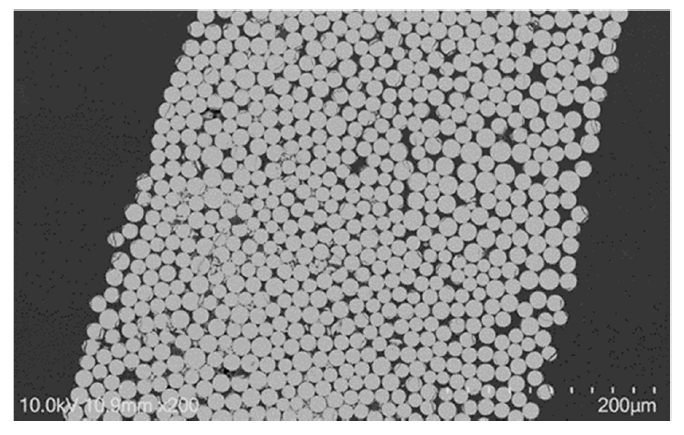
Fully impregnated nylon 6 organosheet
- Additional Advantages for Glass Fiber Composites
JM’s reactive glass product, has the sizing chemistry tailored for promoting the polymerization of caprolactam. The reactive sites on glass fiber surfaces provide strong fiber-resin bonding, resulting in improved properties of the glass fiber nylon 6 composites.
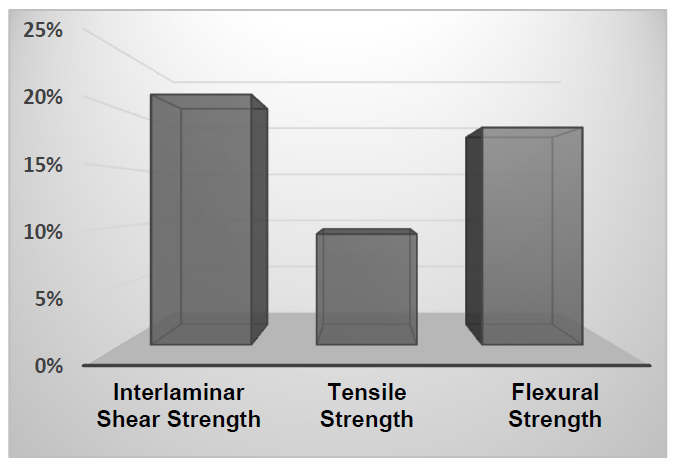 Improvement in composite properties achieved with JM reactive glass products
Improvement in composite properties achieved with JM reactive glass products- AP Nylon Composites Portfolio and Key Attributes
JM has created a portfolio of nylon 6 thermoplastic composite sheets that offer a wide range of material solutions. The product portfolio includes:
OS-6 Series – Nylon 6 organosheets based on woven fabrics
OS-6 Series Resin Nylon 6 Fibers* Continuous, Woven Strength ... Stiffness .... Impact Resistance .... Formability .. - Advantages of JM AP Nylon Composites over other Thermoplastic Composite Sheets
The new JM advanced composites are produced through impregnation and in situ polymerization of caprolactam, a very low viscosity monomer. This leads to:
- Lower cost
- Complete impregnation of complex fabrics
- Ultra-low void composites
- High molecular weight nylon 6 due to anionic polymerization of caprolactam
Applications & Uses
- Applications
- Composites End Use
- Composites Processing Methods
- Plastics & Elastomers Processing Methods
- Applications and Processing
Organosheets in OS-6 series are ideal structural reinforcement solutions for lightweight parts. They are suitable for high throughput manufacturing processes, such as injection overmolding and compression overmolding, and enable the incorporation of complex features into structural thermoplastic composites while meeting short cycle time requirements.
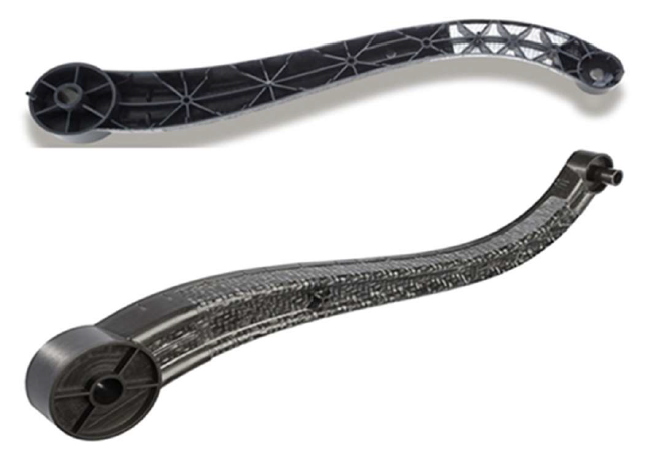
Example of overmolded features for lightweight automotive parts containing OS-6 series nylon 6 organosheets. Courtesy of ARBURG GmbH + Co KG and GKTool
- Applications and Processing
JM’s nylon 6 composite sheets are ideal for applications requiring:
• light-weighting
• part integration
• design flexibility
• high volume composite manufacturing
• short cycle time
• recyclabilityOS-6 series and NCF-6 series products are ideal for hybrid molding processes such as injection and compression overmolding. CR-6 series products are excellent for thermoforming, stamping, and other compression applications.
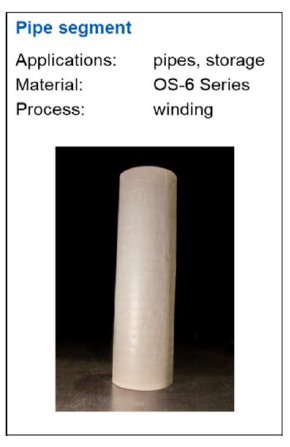
Properties
- Mechanical Properties
- Typical Properties
- Thermal Properties
- Notes
- (1) - Test specimens 250 mm x 25 mm x 2 mm
- (2) - Specimens conditioned according to ISO 1110, in an atmosphere of (70 ± 1) °C and (62 ± 1) % relative humidity
- (3) - Specimens dry, as manufactured
- (4) - Test specimens 80 mm x 25 mm x 2 mm
- (5) - To be validated at full manufacturing capability.
| Value | Units | Test Method / Conditions | |
| Tensile Modulus (at 23°C, Dry (3.5)) | min. 23 | GPa | ISO 527-4/5 |
| Tensile Strength (at 23°C, Dry (3.5)) | min. 390 | MPa | ISO 527-4/5 |
| Tensile Elongation at Break (at 23 °C, Conditioned (3.5)) | approx. 2 | % | ISO 527-4/5 |
| Tensile Modulus (at 23°C, Conditioned (2.5)) | min. 18 | GPa | ISO 527-4/5, ISO 1110 |
| Tensile Strength (at 23°C, Conditioned (2.5)) | min. 380 | MPa | ISO 527-4/5, ISO 1110 |
| Tensile Elongation at Break (at 23 °C, Conditioned (2.5)) | approx. 2 | % | ISO 527-4/5, ISO 1110 |
| Flexural Modulus (at 23°C, Dry (2,5)) | min. 20 | GPa | ISO 14125 (A) |
| Flexural Strength (at 23°C, Dry (2,5)) | min. 580 | MPa | ISO 14125 (A) |
| Flexural Modulus (at 23°C, Conditioned(1,5)) | min. 16 | GPa | ISO 14125 (A), ISO 1110 |
| Flexural Strength (at 23°C, Conditioned(1,5)) | min. 300 | MPa | ISO 14125 (A), ISO 1110 |
| Value | Units | Test Method / Conditions | |
| Weaving Style | 2/2 | twill | DIN ISO 9354 |
| Fabric Area Weight | 1200 | g/m2 | DIN EN 12127 |
| Yarn/Yarn Count | 2400 | tex (g/1000m) | DIN EN 12654-2/3 |
| Weight rate (Longitudinal/Transversal) | 50 | % | - |
| Fiber Content | 47 ± 1 | vol % | - |
| Thickness Per Layer | 1 ± 0.1 | mm | - |
| Sheet Density | 1.83 | g/cm3 | ISO 1183-1 |
| Value | Units | Test Method / Conditions | |
| Melting Temperature (10 K/min) | 215 | °C | ISO 11357-3 |
| Recrystallization Temperature (10 K/min) | 176 | °C | ISO 11357-3 |
| Heat Deflection Temperature (1.8 Mpa) | TBD (5) | °C | ISO 75-1/-3 |
| Coefficient of Linear Thermal Expansion (at -35°C to 23°C) | TBD (5) | E-6/K | ISO 11359-1/2 |
| Coefficient of Linear Thermal Expansion (at 23 °C to 80°C) | TBD (5) | E-6/K | ISO 11359-1/2 |
Regulatory & Compliance
- Certifications & Compliance
Technical Details & Test Data
- JM Proprietary Technology
JM’s expertise in glass fiber manufacturing, an in-depth understanding of fiber-polymer interfaces and constant monitoring of the trends in the composites market led to the development of a pioneering manufacturing technology to produce fully impregnated nylon 6 organosheets. The proprietary technology, covered by multiple U.S. and foreign patents, is versatile in terms of reinforcing materials and can be used to impregnate glass, carbon, aramid and hybrid reinforcements.
Nylon 6 organosheets are produced in a continuous process through the impregnation of fabrics with low viscosity caprolactam monomer, followed by the in situ anionic polymerization of caprolactam to form the thermoplastic polyamide matrix.- Spotlight On Organosheets
What are Organosheets?
Organosheets, also known as organo sheets, are continuous fiber reinforced thermoplastic composite sheets. The term defines composites reinforced primarily with carbon or glass fiber fabrics and has lately been used to encompass a more broad range of semi-finished products which share key advantages coming from thermoplastic matrices (from polypropylene and polyamide-6 to polyethylenimine) and diverse architecture of the reinforcing fibers.

Polyamide 6 organosheets (Courtesy of Johns Manville)
Veterans of the composites industry often refer to organosheets as “thermoplastic prepregs” since it is an intuitive way to describe them by analogy with the continuous fiber reinforced thermoset composites encountered today in structural applications. The origin of the name organosheet is the German noun Organoblech, which embeds a strong built-in advantage: these sheets contain fully polymerized thermoplastics polymers (organic materials). Unlike the prepregs, which have limited shelf-life, require refrigeration and specific inventory control and handling, organosheets have unlimited shelf life under normal storage conditions, can be cut to shape, stacked and integrated in automated manufacturing processes that resemble the processing of metal sheets. This similarity to metal sheets, also referred to as blanks by the metal component stampers, is particularly helpful when discussing applications with automotive industry stakeholders.
Organosheets Today
The industries which have adopted organosheets early on (sporting goods, consumer products, automotive) have high volumes and a need for short cycle time. This is also true in the automotive industry where organosheet applications of increased complexity are now being found. Leading equipment manufacturers have proven the technical readiness of organosheet technology and are delivering processing cells able to produce over 200,000 parts per year from one manufacturing line.
Experimenting with Organosheets
Organosheets can be thermoformed, compression molded, or incorporated in hybrid molding processes. If you are new to organosheets but such processes are in your portfolio, experimenting with these versatile composites might be easier than you think. Here is a handful of tips to get started.
Start with what you have
Use existing equipment and tools and reach out to material manufacturers for guidance on processing steps and conditions. Organosheets have to be heated above the polymer’s melting point before being formed. If you do not already have a heat source for a thermoforming operation, consider adding a low-cost infrared heater to preheat the sheets before placing into the mold. Always plan for proper ventilation when experimenting with new thermoplastic composites.Select organosheets which are right for you
All organosheets are not equal and selecting the appropriate configuration is important for processability, performance and ultimately for cost. Organosheets are defined by the thermoplastic polymer, type of fiber reinforcement (e.g. glass fiber or carbon fiber), fiber architecture (unidirectional, woven fabric, non-crimp fabric), and sheet thickness. A single sheet may contain one layer (or lamina) or multiple layers.
Service temperature and environmental conditions required for an application will determine the polymer selection. Part complexity, the need for drapeability and the load requirements will guide the selection of reinforcement and fiber architecture. Organosheets based on woven fabrics allow good drapeability. Organosheets based on non-crimp fabrics (NCF) will allow more flexibility in design according to the load path and might save weight but will add cost.Pay attention to load requirements
Understanding load requirements is important for controlling material cost and mass. If a critical load path can be addressed using 2 mm thick organosheet based on a complex NCF fabric, or by a thicker organosheet based on woven fabric, the more expensive NCF organosheet might lead to a more cost-effective and mass saving solution overall. Organosheets with localized UD-tape reinforcement are elegant solutions as well and can help balance the cost - mass equation.Use simulations and check all assumptions
Use simulations as early as possible to optimize a design. Today, software providers can guide through functionalities designed specifically for organosheets, making the screening very approachable. To get accurate results it is important to understand and to leverage the orthotropy of these materials (unique behavior in x, y and z directions). For example, while an organosheet based on 2/2 twill or plain weave fabric shows similar performance in two directions (warp and weft), the assumption of isotropy will be incorrect.
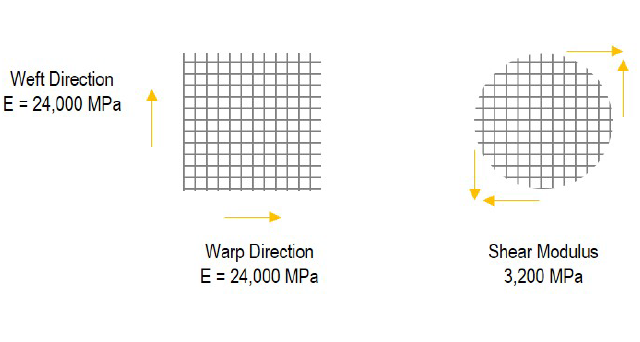
Orthotropic behavior of woven fabric-based organosheets
Jiuheng Chen, Design Engineer at Forward Engineering GmbH, illustrates this very simply. If the organosheet would be isotropic, the shear modulus could be calculated using the elastic modulus and Poison’s ratio as E/2(1+ν) = 24,000/2(1+0.15) = 10,435 MPa. In reality, the material is orthotropic, exhibits a shear modulus of ~3,200 MPa, and should be modeled accordingly.
Reach out to your network
Use the collaborative environment in the composites industry value chain. Providing composite solutions requires good understanding of materials, processes, design, and manufacturing cost. A good network of partners can help obtain answers to questions early on and focus on solutions most likely to succeed.Organosheets Tomorrow
While the cornerstone characteristics of organosheets – light weight, recyclability, fast processability, and suitability for high volume applications – are highlighted more often, at the core of their accelerated adoption are key properties which enable high volume industries to offer new products faster, to personalize models and to incorporate multiple design features.
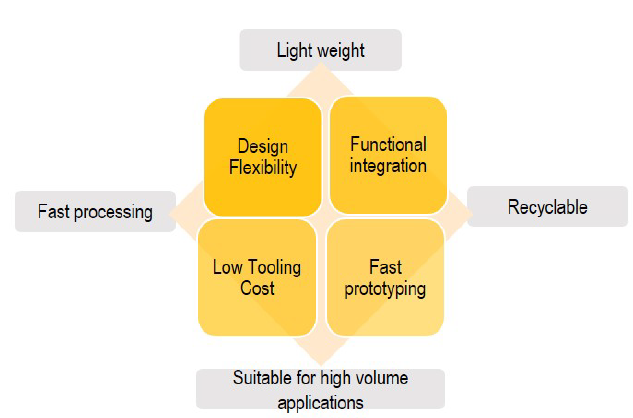
Advantages of organosheets
Organosheets enable a large extent of functional integration (from brackets and metal insets to sensors and electromagnetic interference shielding solutions). Thermoplastic solutions centered on organosheets are easy to prototype and result in significant reduction of parts, lower tooling costs and scalability to high volume. It is the core advantages of organosheets that will bring the most value to an application.
- AP Nylon Technology Platform
JM’s expertise in glass fiber manufacturing and in-depth understanding of fiber-polymer
interfaces in composites led to the development of a pioneering manufacturing technology to produce fully impregnated nylon 6 composite sheets. The proprietary technology, covered by multiple U.S. and foreign patents, is versatile in terms of reinforcing materials and can be used to impregnate glass, carbon, aramid and hybrid reinforcements. Nylon 6 composite sheets are produced in a continuous process through the impregnation of fiber reinforcements with low viscosity caprolactam monomer, followed by the in situ anionic polymerization of caprolactam to form the thermoplastic polyamide matrix.





